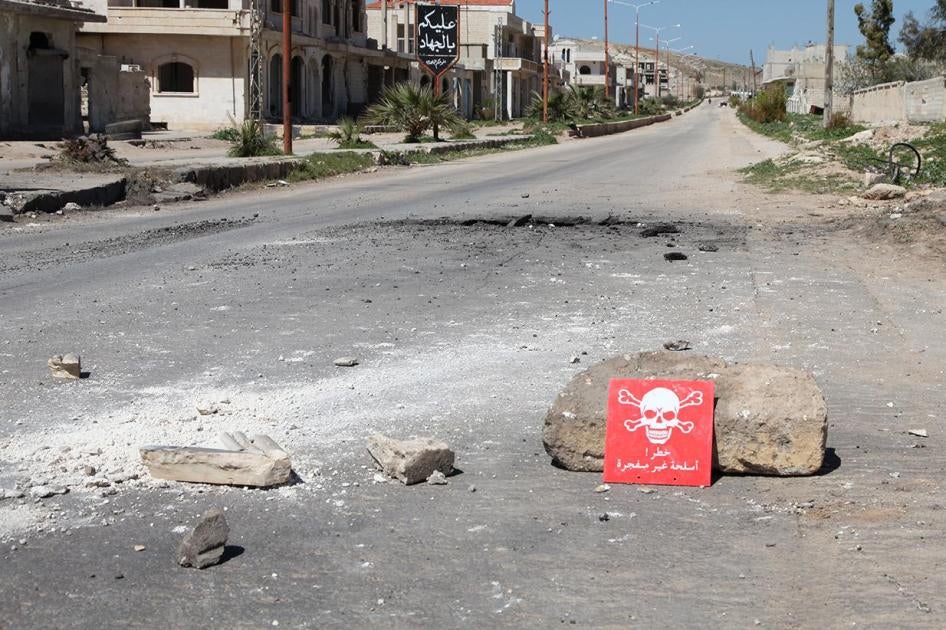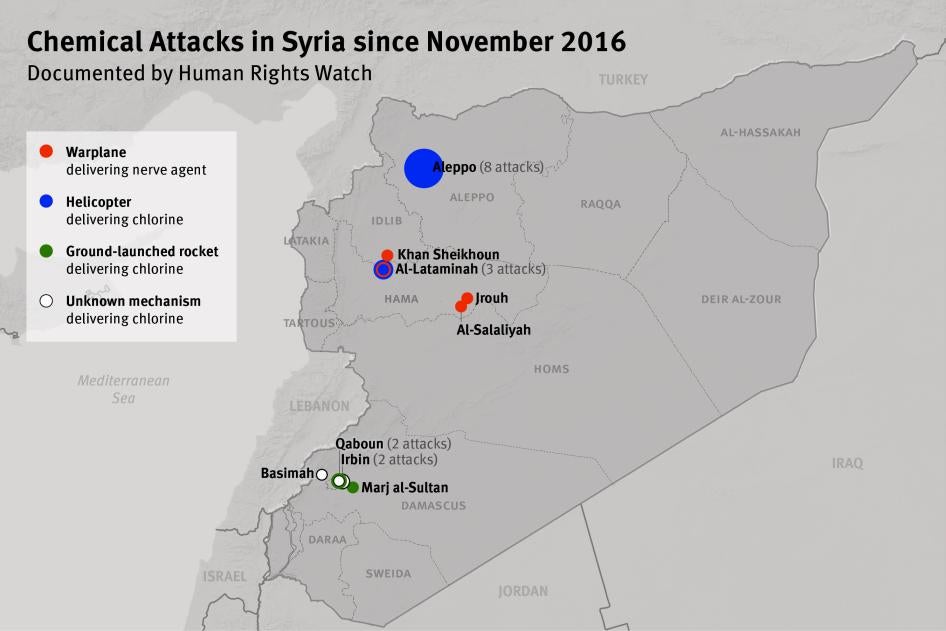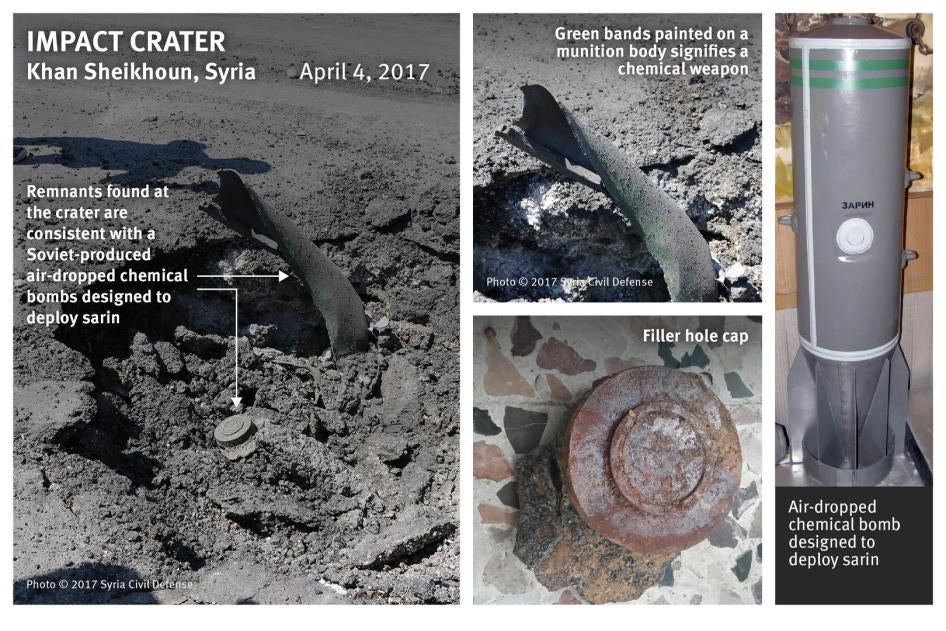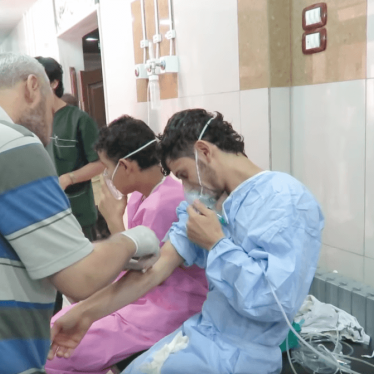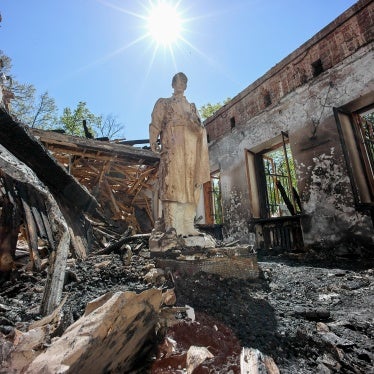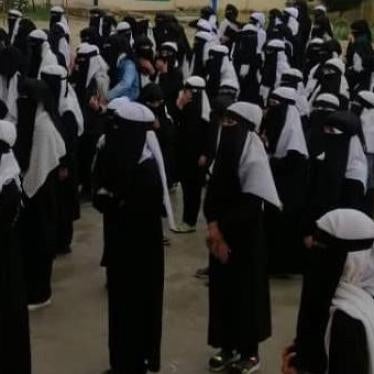(New York) – New evidence supports the conclusion that Syrian government forces have used nerve agents on at least four occasions in recent months: on April 4, 2017, in a chemical attack on Khan Sheikhoun that killed at least 90 people, and on three other occasions in December 2016 and March 2017, Human Rights Watch said in a report released today.
These attacks are part of a broader pattern of Syrian government forces’ use of chemical weapons. The attacks are widespread and systematic and in some cases have been directed against the civilian population. These two features mean the attacks could meet the legal standard required to characterize them as crimes against humanity. As part of the evidence showing these attacks have become widespread and systematic, the 48-page report, “Death by Chemicals: The Syrian Government’s Widespread and Systematic Use of Chemical Weapons,” identifies three different systems being used to deliver chemical weapons:
- Government warplanes appear to have dropped bombs with nerve agents on at least four occasions since December 12;
- Government helicopter-dropped chlorine-filled munitions have become more systematic;
- Government or pro-government ground forces have started using improvised ground-launched munitions filled with chlorine.

In at least some of the attacks, the intention appears to have been to inflict severe suffering on the civilian population.
What appears to be repeated use of nerve agents undermines Syrian and Russian officials’ claims that the chemical exposure in Khan Sheikhoun was due to a conventional bomb striking toxic chemicals on the ground. It would not be plausible that conventional bombs struck chemical caches repeatedly across the country.

Photos and videos of weapon remnants that struck Khan Sheikhoun on April 4 appear to be consistent with the characteristics of a Soviet-made air-dropped chemical bomb specifically designed to deliver sarin.
The United Nations Security Council should immediately adopt a resolution calling on all parties to fully cooperate with investigators from the Organisation for the Prohibition of Chemical Weapons and adopt sanctions against anyone UN investigators find to be responsible for these or past chemical attacks in Syria.
Human Rights Watch interviewed 60 people with first-hand knowledge of the chemical attacks and their immediate aftermath, and reviewed dozens of photos and videos of impact sites and victims that were posted online and provided directly by local residents, but was unable to conduct ground investigations of the attack sites.
Information from local residents in Khan Sheikhoun indicates that a warplane flew over the town twice, around 6:45 a.m. on April 4. One resident said he saw the plane drop a bomb near the town’s central bakery in the northern neighborhood during the first fly-over. Several people, including the person who saw the bomb falling, said they heard no explosion but saw smoke and dust rising from the area, consistent with the relatively small explosive charge in a chemical bomb. Several people also confirmed that they saw people injured or heard reports of injuries immediately after the first fly-over. A few minutes later, they said, a warplane dropped three or four high-explosive bombs on the town.
Human Rights Watch identified 90 people, including 30 children, whom local residents and activists said died due to chemical exposure from this attack. Medical personnel said the attack injured hundreds more.
The Syrian Government’s Widespread and Systematic Use of Chemical Weapons
Human Rights Watch reviewed dozens of photos and videos provided by residents of a crater from the impact of the first bomb. Local residents believed this site was the source of the chemical exposure because those who died lived nearby and people who came near it, including first responders, exhibited the strongest symptoms of chemical exposure. One of the first photos of the crater, taken by first responders, shows what appears to be liquid on the asphalt. That would be consistent with the use of a bomb containing sarin, which is in liquid form at room temperature.
The photos and videos of the crater show two remnants from the weapon used: a twisted thin metal fragment with green paint and a smaller circular metal object. Green coloring is widely used on factory-produced weapons to signify that they are chemical. A Soviet-produced, air-dropped sarin bomb exhibited at a museum in Moscow, for example, has two green bands. The circular object seen in photos of the crater appears similar to the cap covering the filling hole on the sarin bomb.
These remnants, combined with witness observations, the victims’ symptoms, and the identification of sarin as the chemical used in the attack by the French and Turkish governments and the Organisation for the Prohibition of Chemical Weapons, suggest that the Syrian warplane dropped a factory-made sarin bomb.
Evidence suggests that the Khan Sheikhoun attack is not the first time government warplanes have dropped nerve agents in recent months. Witnesses described to Human Rights Watch symptoms consistent with exposure to nerve agents that they and other local residents experienced after warplanes attacked eastern Hama on December 11 and 12, 2016, and northern Hama, near Khan Sheikhoun, on March 30, 2017.
The December attacks were in territory controlled by the Islamic State (also known as ISIS), which closely monitors communication, so it has been difficult to reach witnesses. But four witnesses interviewed by phone and two medical personnel interviewed via text message through intermediaries gave consistent accounts of the attacks. An opposition-affiliated activist and local residents provided the names of 64 people who died from chemical exposure in the December attacks.
The suspected nerve agent attack in northern Hama on March 30 caused no deaths but injured dozens of people, both civilians and combatants, according to local residents, medical personnel, and first responders.
All four suspected nerve agent attacks were in areas where offensives by armed forces fighting the government threatened government military air bases.
Government forces’ use of chlorine-filled weapons has also become more widespread and systematic, Human Rights Watch said. During the last month of the battle for Aleppo city, which ended on December 15, helicopters dropped multiple improvised chlorine-filled munitions in a pattern showing that the attacks were part of the overall military strategy to retake the city. Such attacks have continued more recently, for example in al-Lataminah in northern Hama.
Since January 2017, Human Rights Watch has also documented, for the first time since August 2013, the use by government or pro-government ground forces of improvised surface-fired rockets containing chlorine to attack territory near Damascus controlled by armed groups fighting the government.
Greater United States and Russian engagement on Syria and efforts to reach a political settlement in 2016 failed to significantly reduce egregious violations of human rights and humanitarian law.
Essential BackgroundSome of the chemical attacks hit residential areas far from the frontlines without any obvious military target and appear to have killed and injured only civilians, suggesting the Syrian government forces directed at least some of the attacks against the civilian population.
The Syrian government has repeatedly denied using chemical weapons, including in Khan Sheikhoun on April 4. While Russia has carried out aerial attacks in the areas where chemical attacks took place, Human Rights Watch has no information to indicate that Russian authorities have used chemical weapons. However, Russian forces continue to provide active military support to Syrian forces despite extensive evidence that the latter are using chemical weapons and unlawfully attacking civilians.
The Chemical Weapons Convention, which entered into force in 1997, prohibits the development, production, stockpiling, and use of chemical weapons, and requires their destruction. The prohibitions also apply to toxic chemicals with civilian uses, such as chlorine, when they are used as weapons. Syria became a party to the convention in October 2013.
Crimes against humanity consist of specific criminal acts committed on a widespread or systematic basis as part of an “attack on a civilian population,” meaning there is some degree of planning or policy to commit the crime. Such acts include murder and “other inhumane acts of a similar character intentionally causing great suffering or serious injury to body or to mental or physical health.” The prohibition of crimes against humanity is among the most fundamental in international criminal law and can be the basis for individual criminal liability in international courts, as well as in some foreign domestic courts under the principle of universal jurisdiction.
As close allies to Syria, providing active military backing and regular political support, Russia and Iran should pressure the Syrian government to immediately end its use of chemical weapons and to cooperate with investigators. Russia and Iran should cease cooperation with Syrian individuals and military units suspected of involvement in chemical attacks or other war crimes.
Both Russia and China should stop using their veto power in the Security Council to block accountability for serious crimes in Syria and should support referral of the situation in Syria to the International Criminal Court. On April 12, the council failed to condemn the Khan Sheikhoun attack and demand that the Syrian government cooperate with investigators when Russia vetoed a proposed resolution. Meanwhile, all UN member states should support and fund the Syria accountability mechanism established by the UN General Assembly in December 2016.
“The Security Council has already declared that Syria’s past use of chemical weapons is a threat to international security,” Roth said. “As that use continues, it is shameful that Russia prevents the council from even demanding Syria cooperate with investigators.”
